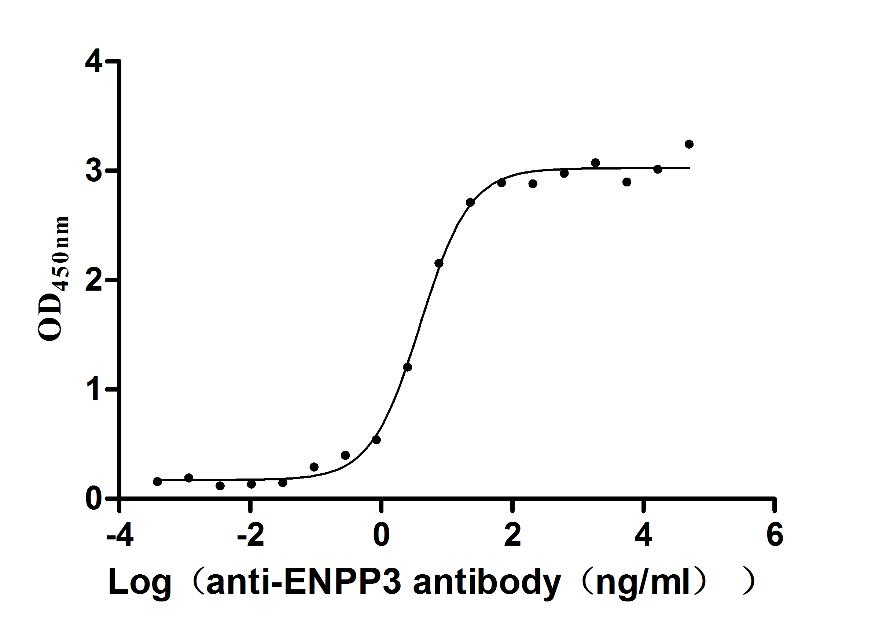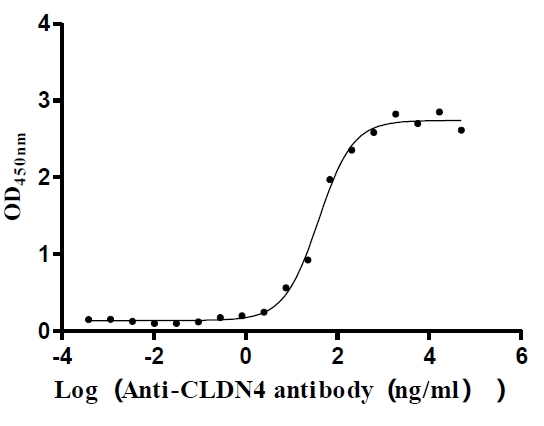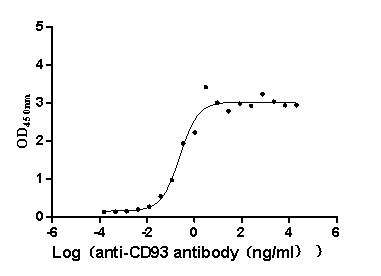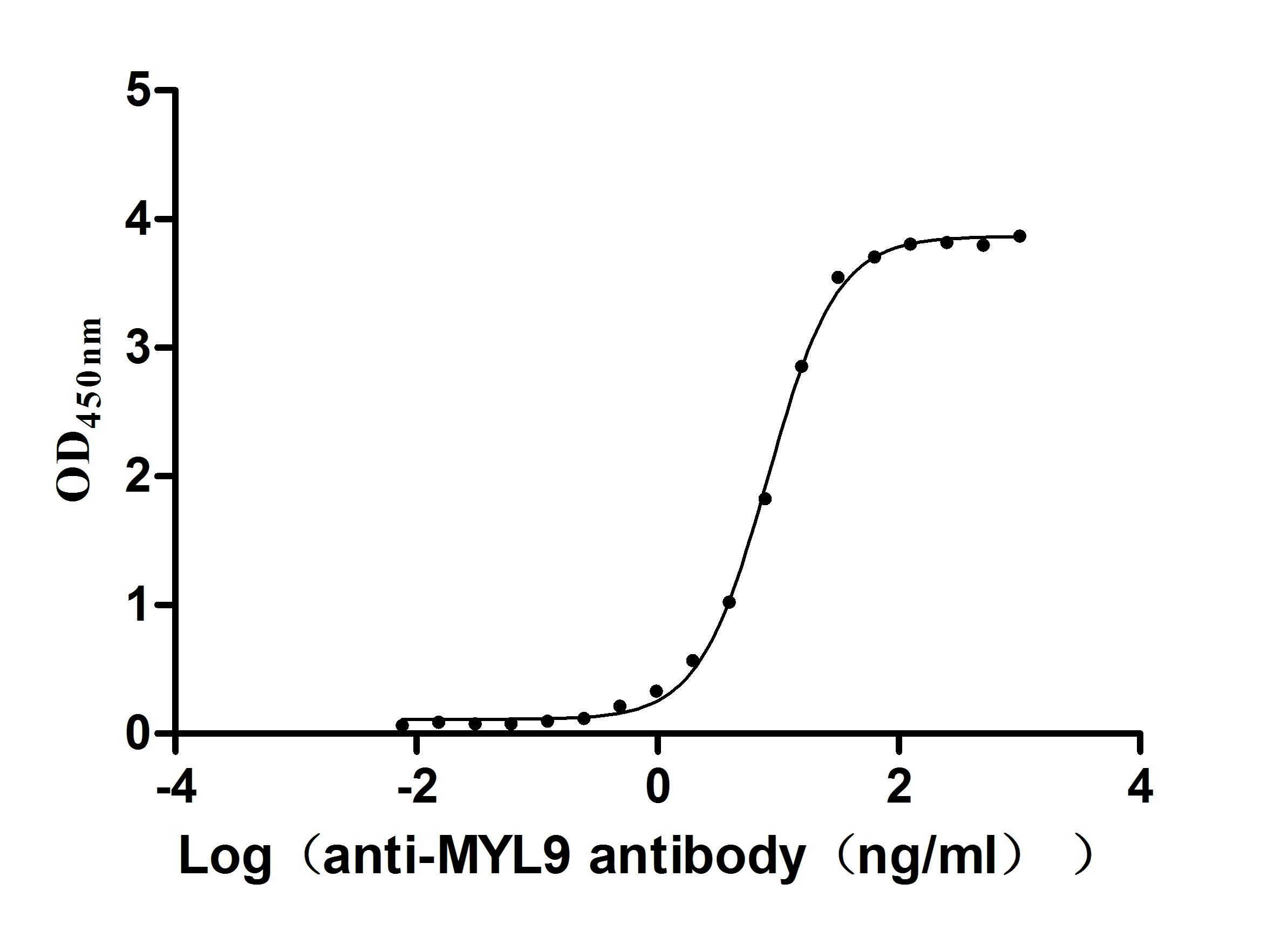Recombinant Human D (2) dopamine receptor (DRD2), partial
-
中文名稱:人DRD2重組蛋白
-
貨號(hào):CSB-YP007179HU1
-
規(guī)格:
-
來(lái)源:Yeast
-
其他:
-
中文名稱:人DRD2重組蛋白
-
貨號(hào):CSB-EP007179HU1-B
-
規(guī)格:
-
來(lái)源:E.coli
-
共軛:Avi-tag Biotinylated
E. coli biotin ligase (BirA) is highly specific in covalently attaching biotin to the 15 amino acid AviTag peptide. This recombinant protein was biotinylated in vivo by AviTag-BirA technology, which method is BriA catalyzes amide linkage between the biotin and the specific lysine of the AviTag.
-
其他:
-
中文名稱:人DRD2重組蛋白
-
貨號(hào):CSB-BP007179HU1
-
規(guī)格:
-
來(lái)源:Baculovirus
-
其他:
-
中文名稱:人DRD2重組蛋白
-
貨號(hào):CSB-MP007179HU1
-
規(guī)格:
-
來(lái)源:Mammalian cell
-
其他:
產(chǎn)品詳情
-
純度:>85% (SDS-PAGE)
-
基因名:
-
Uniprot No.:
-
別名:DRD2; D(2 dopamine receptor; Dopamine D2 receptor
-
種屬:Homo sapiens (Human)
-
蛋白長(zhǎng)度:Partial
-
蛋白標(biāo)簽:Tag?type?will?be?determined?during?the?manufacturing?process.
The tag type will be determined during production process. If you have specified tag type, please tell us and we will develop the specified tag preferentially. -
產(chǎn)品提供形式:Lyophilized powder
Note: We will preferentially ship the format that we have in stock, however, if you have any special requirement for the format, please remark your requirement when placing the order, we will prepare according to your demand. -
復(fù)溶:We recommend that this vial be briefly centrifuged prior to opening to bring the contents to the bottom. Please reconstitute protein in deionized sterile water to a concentration of 0.1-1.0 mg/mL.We recommend to add 5-50% of glycerol (final concentration) and aliquot for long-term storage at -20℃/-80℃. Our default final concentration of glycerol is 50%. Customers could use it as reference.
-
儲(chǔ)存條件:Store at -20°C/-80°C upon receipt, aliquoting is necessary for mutiple use. Avoid repeated freeze-thaw cycles.
-
保質(zhì)期:The shelf life is related to many factors, storage state, buffer ingredients, storage temperature and the stability of the protein itself.
Generally, the shelf life of liquid form is 6 months at -20°C/-80°C. The shelf life of lyophilized form is 12 months at -20°C/-80°C. -
貨期:Delivery time may differ from different purchasing way or location, please kindly consult your local distributors for specific delivery time.Note: All of our proteins are default shipped with normal blue ice packs, if you request to ship with dry ice, please communicate with us in advance and extra fees will be charged.
-
注意事項(xiàng):Repeated freezing and thawing is not recommended. Store working aliquots at 4°C for up to one week.
-
Datasheet :Please contact us to get it.
相關(guān)產(chǎn)品
靶點(diǎn)詳情
-
功能:Dopamine receptor whose activity is mediated by G proteins which inhibit adenylyl cyclase. Positively regulates postnatal regression of retinal hyaloid vessels via suppression of VEGFR2/KDR activity, downstream of OPN5.
-
基因功能參考文獻(xiàn):
- In the overall participants, the DRD2 Taq 1A polymorphism itself was not related to IQ scores in children who had a high level of urine fluoride. In the CC/CT subgroup, urine fluoride levels and IQ scores in children were unrelated. Among the participants carrying the TT genotype, there was a strong and robust negative linear relationship between log-urine fluoride and IQ scores. PMID: 30205328
- this study demonstrated a protective role of D2R in neutrophil-endothelial cell adhesion induced by bradykinin, especially in cytokine-stimulated endothelial cells. PMID: 30148510
- DRD2 Ins/Ins (prevalence ratio (PR)=2.374, 95% confidence interval (CI): 1.105-5.100; P=0.027) and DRD3 Ser/Ser genotypes (PR=1.677, 95% CI 1.077-2.611; P=0.022) were independent and predictors of gastrointestinal symptoms associated with levodopa therapy. PMID: 27779245
- genetically determined differences in DAT1 and DRD2 expression modulate functional consequences of sleep deprivation. PMID: 28393838
- Study represents the first comprehensive investigation of the association between both striatal and extrastriatal D2/D3 receptor binding potential with executive function and verbal learning in medication-naive (5 drug-free) patients with schizophrenia; demonstrates that lower fallypride binding potential in patients with schizophrenia may be associated with better performance. PMID: 28576546
- these results suggest that among schizophrenia patients at the chronic stage, there is a relationship between Del carriers and high-dose pharmacotherapy. PMID: 28285026
- DRD2 C957T significantly affects performance on executive function related tasks in healthy individuals and shows for the first time that some of these effects may be mediated through the impact of childhood traumatic events. PMID: 28523234
- DRD2 gene moderates the relation between maternal history of maltreatment and infant emotion regulation. PMID: 28803562
- The TAQ1A1 allele of the DRD2 gene region contributes to shortened years of survival in alcohol dependent individuals, along with age and gender. PMID: 29236941
- Disruption of DRD2 promoted the proliferation of NSCLC cell lines by inhibiting the NF-kappaB signaling pathway and overexpression not only blocked lipopolysaccharide-induced cell proliferation and growth, but also inhibited the tumorigenesis in murine xenograft models. PMID: 30114693
- our results indicate a reduced natural-reward brain reactivity in smokers with the B1 allele of the DRD2 Taq1B polymorphism as evidenced with the approach-avoidance task. PMID: 28364268
- The G allele of DRD2 rs1800497 SNP was associated with a significant risk reduction of awake-sleep bruxism (p = 0.041). PMID: 28451935
- association to the purified GHSR:D2R heteromer triggers a different active conformation of Galphai that is linked to a higher rate of GTP binding and a faster dissociation from the heteromeric receptor. PMID: 29632174
- crystal structure of DRD2 in complex with the widely prescribed atypical antipsychotic drug risperidone PMID: 29466326
- analysis of molecular dynamics simulations with a cumulative length of ~77 mus of D2R and D3R wild-type and their E2.65A mutants bound to SB269652 PMID: 29337986
- In schizophrenia patients, presence of DRD2 Taq 1 D2D2 and 5-HT2A C516T CT genotypes in patients were more likely to be associated with non-response to risperidone. PMID: 28692863
- These results led us to hypothesize the existence of functional D2-sigma1R complexes on the rat striatal DA and glutamate nerve terminals and functional D2-sigma1R-DA transporter complexes on the striatal DA terminals. PMID: 28923416
- Current smokers showed lower ventral striatum levels of dopamine D2 receptors compared to non-smokers. PMID: 28643800
- The glioma-initiating cells self-renewal function regulated by PRRX1 is mediated by dopamine D2 receptor (DRD2). PRRX1 directly binds to the DRD2 promoter and transactivates its expression in glioma-initiating cells. PMID: 28486630
- ONC201 is a selective DRD2 antagonist that is well tolerated, achieves micromolar plasma concentrations, and is biologically active in advanced cancer patients when orally administered at 625 mg every 3 weeks PMID: 28331050
- DRD2 variation is associated with fiber tract integrity between basal ganglia and frontal cortices. PMID: 28392487
- The G allele of rs4654327 (OPRD1), DRD2 haplotype block CCGCCGTT (rs6277-rs1076560-rs2283265-rs2734833-rs2075652-rs1079596-rs4436578-rs11214607), and OPRD1 haplotypes TACG (rs6669447-rs2236857-rs508448-rs4654327), CG (rs508448-rs4654327), and TG (rs6669447-rs4654327) were significantly associated with heroin dependence phenotype. PMID: 28692418
- The constructed models using 38 D2R ligands (in the training set) were validated with 15 additional test set compounds. The resulting model correctly predicted the pIC50 values of an additional test set compounds as true unknowns PMID: 27367058
- case-control study by genotyping 7 SNPs of SLC6A2, SLC6A3 and DRD2 in 1034 schizophrenia patients and 1034 controls. No significant difference in the allelic or genotypic frequency was detected between cases and controls PMID: 28454051
- Multimodal imaging results suggest that the distribution of D2/3 receptors in the posterior portion of the brain corresponds to the posterior default mode network, as well as to other functional networks to varying degrees. PMID: 28700819
- typical age-related dopamine D2 receptor loss, assessed with PET [18F]fallypride, was significantly reduced in physically active adults compared to less active adults PMID: 28089678
- No correlation was found between DRD2 polymorphisms and CAB responsiveness in patients with prolactinoma. More data are necessary in order to assess the influence of DRD2 genotyping on DA treatment response. PMID: 27848079
- DRD2 C947T (rs6277) may be associated with better performance on select cognitive domains independent of ANKK1 following Traumatic brain injury. PMID: 27826691
- The major allele A of rs2511521 located in DRD2 and the minor allele T of rs625413 located in TIRAP are significantly associated with increased risk of food addiction in overweight/obese subjects with low/zero food addiction symptoms. PMID: 28115213
- finding substantiates the conclusion that the detected community represents a more connected and informative cluster of genes for the DRD2 community, and therefore better elucidates the behavior of this module of strongly related DRD2 genes PMID: 29304112
- The neurotransmitter dopamine is linked to brain areas associated with reward, motivation, and attention, and common dopaminergic variants, DRD$ and DRD2 have been associated with attention difficulties. PMID: 26990357
- [(123)I]IBZM SPECT results show that striatal D2/3R availability increases after long-term bariatric-surgery induced weight loss, suggesting that reduced D2/3R availability in obesity is a reversible phenomenon. PMID: 27184782
- 3-chlorotyramine possesses a significant affinity by the D2 -DR. PMID: 27490860
- DRD2 C957T SNP influences flow proneness. PMID: 26954487
- Neurotransmission through D2-type receptors in the anterior cingulate and anterior insular cortices influences capacity of emotion processing in healthy people but that this association is absent in individuals with methamphetamine dependence. PMID: 26657175
- Suggest an effect of smoking on ventral striatal D2/3 dopamine receptors that may contribute to nicotine dependence. PMID: 27634830
- An association has been found between the DRD2/ANKK1 gene and alcohol use, and cognition. PMID: 27399274
- Data support the hypothesis of a negative influence of D2/3 receptor blockade on specific cognitive functions in schizophrenia. PMID: 26819282
- the D2 receptor system is associated with electrophysiological correlates of outcome evaluation processes PMID: 27021648
- DRD2/ANKK1-Taq1A gene is not a significant risk factor in the evolution of writer's cramp. PMID: 27696930
- DRD2/ANKK1 TaqIA allele status predicts striatal D2R specific binding as measured by D2R-selective [11C]NMB. PMID: 27241797
- DRD2 Taq1A may affect antipsychotic-related PRL levels in schizophrenic patients. PMID: 27333159
- Involvement of DRD2 not only in schizophrenia but also in elevated levels of blood glucose. PMID: 27254804
- The most characteristic signaling pathways for B2R and D2R, dependent on intracellular Ca(2+) and cAMP concentration, respectively, were analyzed in cells presenting similar endogenous expression of B2R and D2R.The evidence of B2R-D2R dimerization may open new perspectives in the modulation of diverse cellular functions which depend on their activation. PMID: 28757212
- In acute schizophrenia patients, the mRNA expression levels of DRD2 and PI3KCB were significantly lower than those in the healthy controls, while the AKT1 mRNA levels were significantly higher than those in the healthy controls. PMID: 27449010
- Our data support the critical role of C957T in striatal D2/3 receptor availability. This work has implications for a number of psychiatric conditions in which dopamine signaling and variation in C957T status have been implicated, including schizophrenia and substance use disorders. PMID: 28398340
- Further analysis revealed that the adenosine agonist 5'-N-ethylcarboxamidoadenosine, a previously identified promoter of b cell proliferation, acted with DPD to increase the number of b cells. In humans, dopamine also modulates b cell mass through DRD2 and exerts an inhibitory effect on adenosine signaling. PMID: 27373926
- Greater predicted DRD2 pathway prefrontal co-expression was associated with greater prefrontal activity and longer working memory reaction times in schizophrenic patients. PMID: 28094815
- Lowering the level of cellular FLNA caused an elevation in RalA activity and resulted in selective interference with the normal intracellular trafficking and signaling of D2R through GRK2. Knockdown of FLNA or coexpression of active RalA interfered with the recycling of the internalized D2R and resulted in the development of receptor tolerance. Active RalA was found to interact with GRK2 to sequester it from D2R. PMID: 27188791
- Using the human glycosylated native conformational D2R, study shows the importance of D2R extracellular N-terminus in regulating receptor availability at the cell surface, human anti-D2R antibody binding, and potential pathogenic mechanisms of these antibodies. PMID: 27908295
顯示更多
收起更多
-
亞細(xì)胞定位:Cell membrane; Multi-pass membrane protein. Golgi apparatus membrane; Multi-pass membrane protein.
-
蛋白家族:G-protein coupled receptor 1 family
-
組織特異性:[Isoform 1]: Expressed in the anterior pituitary gland.; [Isoform 2]: Expressed in the anterior pituitary gland.
-
數(shù)據(jù)庫(kù)鏈接:
Most popular with customers
-
Express system: Mammalian cell
Species: Macaca fascicularis (Crab-eating macaque) (Cynomolgus monkey)
-
Recombinant Mouse Claudin-18 (Cldn18)-VLPs (Active)
Express system: Mammalian cell
Species: Mus musculus (Mouse)
-
Recombinant Human Claudin-4 (CLDN4)-VLPs (Active)
Express system: Mammalian cell
Species: Homo sapiens (Human)
-
Recombinant Human Microtubule-associated protein tau (MAPT) (Active)
Express system: Mammalian cell
Species: Homo sapiens (Human)
-
Recombinant Macaca fascicularis CD93 molecule (CD93), partial (Active)
Express system: Mammalian cell
Species: Macaca fascicularis (Crab-eating macaque) (Cynomolgus monkey)
-
Recombinant Macaca fascicularis Trophoblast glycoprotein (TPBG), partial (Active)
Express system: Mammalian cell
Species: Macaca fascicularis (Crab-eating macaque) (Cynomolgus monkey)
-
Recombinant Human Cytotoxic and regulatory T-cell molecule (CRTAM), partial (Active)
Express system: Mammalian cell
Species: Homo sapiens (Human)
-
Recombinant Human Myosin regulatory light chain 12B(MYL12B) (Active)
Express system: E.coli
Species: Homo sapiens (Human)



-AC1.jpg)

-AC1.jpg)














